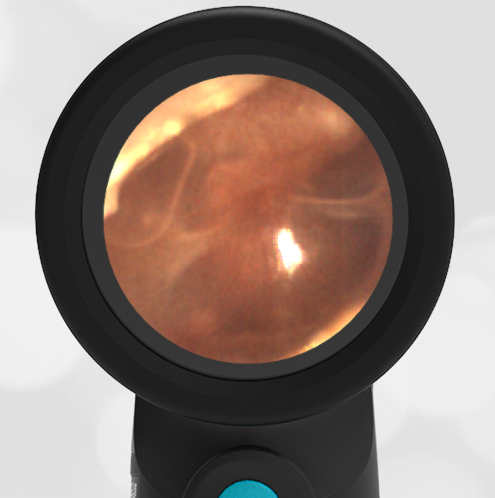
28 Month-Old with Fussiness
A 28-month-old presented to the Emergency Department (ED) for “pulling at his ear” and fussiness. The mother reported her child was recently treated for an ear infection with amoxicillin, completing the course of antibiotics five days prior. She denied fevers but described occasional wheezes that improved with the use of his inhaler. In the ED, his temperature was noted to be 38.5o C. His physical exam demonstrated rhinorrhea, clear lung sounds, and no increased work of breathing. His Wispr digital otoscope exam is shown.
Which of the following best describes the child’s Wispr findings?
A. The tympanic membrane (TM) is consistent with acute otitis media
B. The TM is normal
C. The TM has a middle ear effusion
D. Urgent referral to otolaryngology (ENT) is indicated
The TM is not normal. This child has mild bulging of the right TM as evidenced by an indistinct malleus (only the tip of the lateral process is visible due to bulging of the pars flaccida) as well as a depression centrally where the fixed attachment of the umbo is located. These two anatomic features give the appearance of a “full” TM. With moderate to severe bulging, this central depression deepens to give the appearance of an “angry donut” and is diagnostic of acute otitis media (AOM), which is not present here. The TM is nicely translucent, allowing for visualization of several air-fluid levels, consistent with otitis media with effusion (OME). OME is no indication for a referral to ENT.
This child’s TM findings are not unusual for a toddler with either a recent acute otitis media (AOM), an evolving AOM, and/or an upper respiratory illness. The air fluid levels will resolve with ventilation through the Eustachian tube. No further management is necessary, and the parents should be given return instructions for fever or worsening fussiness.
Key Learning Points
-Otitis media with effusion (OME) is a common sequelae to a viral infection. The hallmark of OME is air-fluid levels behind the tympanic membrane without bulging.
-OME generally resolves on its own and does not require intervention.



